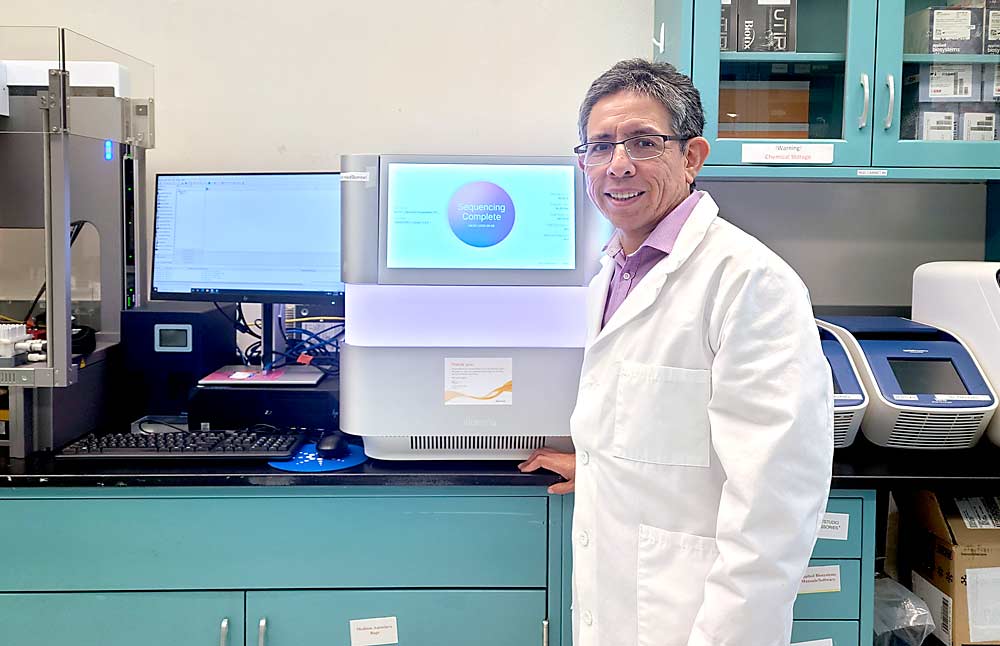
Imported fruit tree varieties go through a long and involved process to ensure they are virus-free before they are planted in the United States. Until recently, that meant five to seven years of quarantine, including multiple graftings and laborious manual inspections to search for visible signs of infection.
Enter new technology.
In 2021, the U.S. Department of Agriculture changed its protocol to allow an approach driven more by genetic testing that reduces the quarantine period to as little as two years. Now, USDA scientists are testing an advanced molecular technique that shows potential to shave off additional time and cost from one of the crucial steps in the current process.
Today’s method of testing imported plants for viruses (and virus-like plant pathogens called viroids) relies heavily on polymerase chain reaction (PCR), the same technology used to screen a human nasal-swab sample for the presence of the COVID-19 virus. Be it trees or people, each PCR test checks a sample for the presence of one specific virus, so to check for multiple viruses, technicians must run multiple PCRs. For imported trees, this equates to four to six weeks of PCR testing in each of two consecutive years.
The new technique speeds the process by testing for an entire series of common fruit tree viruses and viroids at once rather than one at a time, according to co-developer Oscar Hurtado-Gonzales. He is the lead plant pathologist in the USDA Animal and Plant Health Inspection Service (APHIS). The approach stems from a highly efficient and rapid technology developed by pathologist Kurt Lamour at the University of Tennessee. (Lamour is commercializing the technology, called MonsterPlex, through his company, Floodlight Genomics.)
Once Hurtado-Gonzales learned of the technology, he and his team of scientists at APHIS collaborated with Lamour to adapt the technology to screen for tree-fruit viruses.
To do it, APHIS researchers began generating a set of virus detectors, called initiators, that would target specific regions on the genomes of a wide variety of common stone fruit and pome fruit viruses and viroids, as well as different strains of the viruses. Once they had the set of initiators, they tried it out using Lamour’s technology, which includes powerful “multiplexing” PCR and high-throughput sequencing that together can read genetic code extremely quickly and find multiple targets at once.
“We tested all our positive controls that we know that had viruses and viroids, and it just worked amazing. We could not believe it,” Hurtado-Gonzales said.
In a study published in the journal Frontiers in Plant Science, the researchers showed that just one multiplexing PCR run followed by a single sequencing run could accurately diagnose 34 of the common viruses and viroids. And, it can test up to 123 pome and stone fruit samples simultaneously.
“This robust and high-throughput, cost-effective diagnostic tool will enhance the viral/viroid knowledge of fruit trees while increasing the capacity for large-scale diagnostics,” the researchers concluded in that study.
Overall, the study showed that the new approach decreased each of the current four- to six-week PCR testing periods to just one week, Hurtado-Gonzales said.
The technology could also do virus testing of trees already in growers’ orchards.
“It’s an interesting approach that could reduce the number of individual PCR assays that have to be performed in the laboratory, and so would be appealing for diagnostic companies testing grower samples,” said Scott J. Harper, Washington State University plant pathologist. He serves as director of the Clean Plant Center Northwest, which helps provide clean plant material to protect U.S. specialty crop producers and was not part of the technology development.
While Hurtado-Gonzales hopes the technique will one day be incorporated into the USDA-approved protocols for determining the virus-free status of imported fruit trees, it needs further validation and sensitivity testing.
“It is still a work in progress,” he said.
Hurtado-Gonzales is now applying the technique through collaborations with fruit tree researchers from various universities and state agricultural agencies. In the meantime, the National Clean Plant Network and the APHIS Plant Protection and Quarantine program will continue working to bring growers a wide selection of fruit trees while ensuring, he said, “we also stop any viruses that might be propagating or trying to enter into the country.”
—by Leslie Mertz






Leave A Comment